Little Fox |
|||||||||||||
 |
 |
||||||||||||
Knitted sweater with raglan for babies and kids in DROPS Sky. The piece is worked top down with fox-pattern. Sizes 1 month – 8 years.
DROPS Baby 36-14 |
|||||||||||||
|
------------------------------------------------------- EXPLANATIONS FOR THE PATTERN: ------------------------------------------------------- RIDGE/GARTER STITCH (worked back and forth): Knit all rows. 1 ridge in height = Knit 2 rows. PATTERN: Diagrams A.1 to A.3 – choose diagram for your size. The whole of diagram A.1 is worked in stockinette stitch. The diagrams show all rows in the pattern from the right side. When working with 2 colors, work with more than 1 strand of each color to avoid long strands on the wrong side. You can use the strand from both the inside and outside of the ball. I.e. the first part of A.1 is knitted with 5 threads (1 thread hazelnut, 1 thread light beige, 1 thread hazelnut, 1 thread light beige, 1 thread hazelnut), the rest of A.1 is knitted with 3 threads ( 1 thread hazelnut, 1 thread light beige, 1 thread hazelnut) NOTE: To avoid holes when changing color, twist the 2 strands together. Diagrams A.2 and A.3 show how the ears are sewn with duplicate stitches. INCREASE TIP: All increases are worked from the right side! Increase 1 stitch after marker 1, work until there is 1 stitch left before markers 2, 3 and 4, 1 yarn over, work 2 stitches (markers sit between these 2 stitches), 1 yarn over and increase 1 stitch before marker 5 (= 8 stitches increased). Increase by making 1 yarn over, which is worked twisted on the next row to avoid holes. DECREASE TIP (for sleeves): Decrease 1 stitch on each side of the marker as follows: Work until there are 3 stitches left before the marker, knit 2 together, knit 2 (marker sits between these 2 stitches), slip 1 stitch as if to knit, knit 1 and pass the slipped stitch over the knitted stitch (= 2 stitches decreased). BINDING-OFF TIP: To avoid the bind-off edge being tight you can bind off with a larger size needle. If the edge is still tight, make 1 yarn over after approx. each 4th stitch at the same time as binding off and the yarn overs are bind off as normal stitches. ------------------------------------------------------- START THE PIECE HERE: ------------------------------------------------------- SWEATER – SHORT OVERVIEW OF THE PIECE: The piece is worked top down. The yoke is worked back and forth with circular needle, before it is divided for sleeves and body. The body is continued back and forth with circular needle. The sleeves are worked in the round with double pointed needles. YOKE: Cast on 56-60-60 (68-72-72-76) stitches (including 1 edge stitch on each side) with circular needle size 3.5 mm = US 4 and hazelnut. Purl 1 row from the wrong side. Then work rib as follows: Work 1 edge stitch in GARTER STITCH – read description above, * knit 2, purl 2 *, work from *-* until there are 3 stitches left, knit 2 and 1 edge stitch in garter stitch. When the rib measures 1½ to 2 cm = ½" to ¾", change to circular needle size 4.5 mm = US 7. Insert 5 markers in the piece and increase evenly from the right side as follows: Work 1 edge stitch in garter stitch, knit 1, insert marker 1, knit 7 and increase 2-4-2 (2-2-2-2) stitches evenly, insert marker 2 (= left sleeve), knit 21-23-23 (27-29-29-31) and increase 2-2-2 (1-1-2-1) stitches evenly, insert marker 3 (= back piece), knit 8 and increase 2-4-2 (2-2-2-2) stitches evenly, insert marker 4 (= right sleeve), knit 16-18-18 (22-24-24-26) and increase 2-2-2 (1-1-2-1) stitches evenly, insert marker 5, knit 1 and finish with 1 edge stitch in garter stitch = 64-72-68 (74-78-80-82) stitches. Continue with stockinette stitch and 1 edge stitch in garter stitch on each side and increase to raglan on each row from the right side as follows: Increase at each marker – read INCREASE TIP, a total of 13-14-15 (16-17-18-19) times = 168-184-188 (202-214-224-234) stitches. REMEMBER THE KNITTING GAUGE! Work until the piece measures 12-13-15 (16-17-18-19) cm = 4¾"-5⅛"-6" (6¼"-6¾"-7"-7½") from the cast-on edge. Now divide the piece for body and sleeves on the next row from the right side as follows: Work 1 stitch in garter stitch, place the next 36-40-40 (42-44-46-48) stitches on 1 thread for the sleeve and cast on 4-4-6 (6-6-6-6) stitches under the sleeve, knit 49-53-55 (60-64-67-70) stitches (= back piece), place the next 36-40-40 (42-44-46-48) stitches on 1 thread for the sleeve and cast on 4-4-6 (6-6-6-6) stitches under the sleeve, knit 45-49-51 (56-60-63-66) stitches, 1 stitch in garter stitch and cast on 4-4-4 (4-4-4-5) stitches at the end of the row = 108-116-124 (134-142-148-155) stitches. BODY: Continue back and forth with stockinette stitch and 1 edge stitch in garter stitch on each side until the piece measures 0-0-0 (0-1-2-3) cm = 0"-0"-0" (0"-⅜"-¾"-1⅛") from the division. Now work A.1 on the front piece as follows: Work 1 edge stitch in garter stitch, stockinette stitch over 62-68-72 (76-82-84-89) stitches, A.1 (= 35-35-39 (46-46-51-51) stitches), stockinette stitch over 9-11-11 (10-12-11-13) stitches and 1 edge stitch in garter stitch. Continue this pattern. When A.1 has been worked 1 time in height, finish the piece with hazelnut. Work stockinette stitch with 1 edge stitch in garter stitch on each side until the piece measures 12-13-14 (17-20-22-25) cm = 4¾"-5⅛"-5½" (6¾"-8"-8¾"-9¾") from the division. On the next row from the right side increase 2-2-2 (0-0-2-3) stitches evenly spaced = 110-118-126 (134-142-150-158) stitches. Change to circular needle size 3.5 mm = US 4. On the next row from the right side work rib as follows: 1 edge stitch in garter stitch, * knit 2, purl 2 *, work from *-* until there is 1 stitch left and finish with 1 edge stitch in garter stitch. Bind off with knit from the right side when the rib measures 3 cm = 1⅛" – read BINDING-OFF TIP. The sweater measures approx. 28-30-33 (36-40-44-48) cm = 11"-11¾"-13" (14¼"-15¾"-17¼"-19") from the shoulder down. SLEEVE: Place the 36-40-40 (42-44-46-48) stitches from the thread on the one side of the piece on double pointed needles size 4.5 mm = US 7 and knit up 1 stitch in each of the 4-4-6 (6-6-6-6) stitches cast on under the sleeve = 40-44-46 (48-50-52-54) stitches. Insert 1 marker in the middle of the 4-4-6 (6-6-6-6) stitches under the sleeve. Allow the marker to follow your work onwards; it will be used when decreasing under the sleeve. Work stockinette stitch in the round. When the sleeve measures 2 cm = ¾" from the division decrease 1 stitch on each side of the marker – read DECREASE TIP! Decrease like this every 2-2-1½ (2½-3½-4-5) cm = ¾"-¾"-½" (7/8"-1¼"-1½"-2") a total of 3-4-5 (5-5-5-5) times = 34-36-36 (38-40-42-44) stitches. When the sleeve measures 10-12-13 (16-21-25-28) cm = 4"-4¾"-5 1/8 (6¼"-8¼"-9¾"-11") from the division decrease 2-0-0 (2-0-2-0) stitches evenly spaced = 32-36-36 (36-40-40-44) stitches. Change to double pointed needles size 3.5 mm = US 4 and work rib (= knit 2, purl 2). Bind off with knit when the rib measures 3 cm = 1⅛". Work the other sleeve in the same way. RAGLAN-BAND: Knit up from the right side approx. 28 to 36 stitches (divisible by 4) inside the 1 edge stitch along the sleeve’s raglan-opening with circular needle size 3.5 mm = US 4 and hazelnut. Work rib (= knit 2, purl 2) with 1 edge stitch in garter stitch and 2 knitted stitches on each side (seen from the right side). When the band measures 2 cm = ¾", bind off with knit over knit and purl over purl. Repeat along the raglan-opening on the front piece but when the band measures 1 cm = ⅜" work 4 buttonholes evenly spaced. 1 buttonhole = purl 2 together in the purled section, (seen from the right side) and make 1 yarn over. ASSEMBLY: Sew the side seam inside the 1 edge stitch. Embroider the fox’s eyes and nose on the front piece using black. The ears are sewn using duplicate stitches and light beige, according to diagrams A.2 and A.3. The stitches are sewn top down. The stitch with the arrow and a star in diagrams A.2 and A.3, is sewn approx. 2 rows above the stitch with the arrow and a star in A.1. Sew the bands at the bottom of the raglan-openings (this is where the body starts) – the band on the front piece should lie over the band on the sleeve. Sew buttons onto the band on the sleeve. |
|||||||||||||
Diagram explanations |
|||||||||||||
|
|||||||||||||

|
|||||||||||||
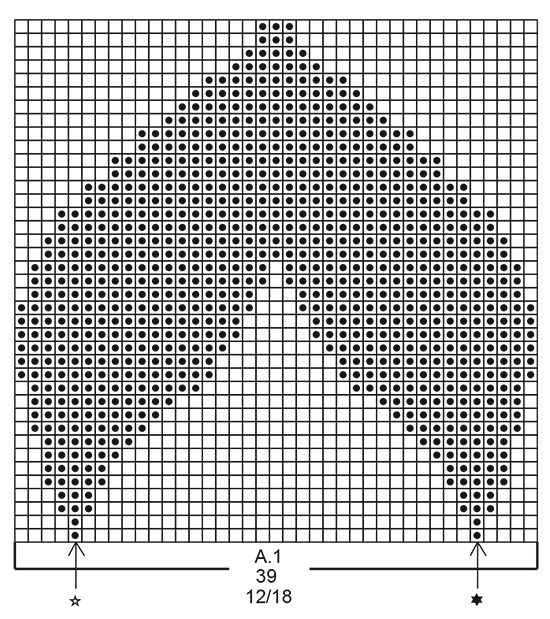
|
|||||||||||||
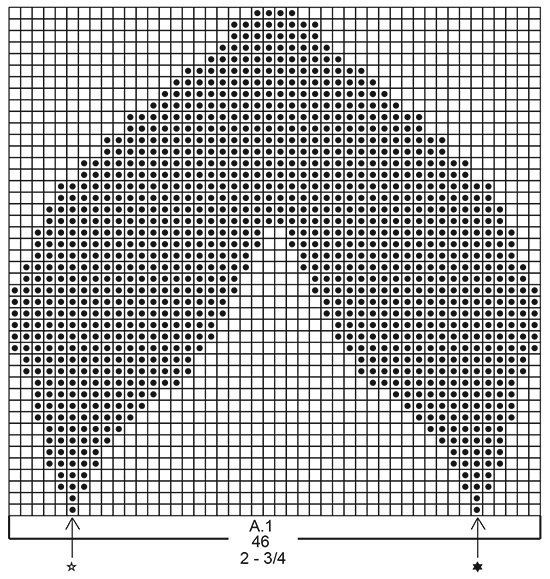
|
|||||||||||||
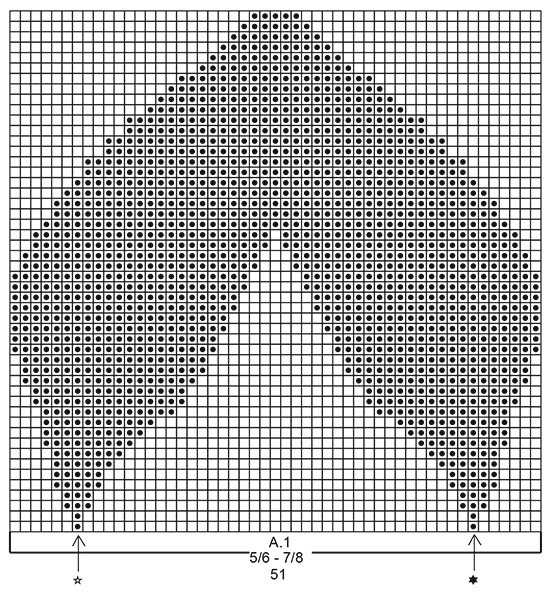
|
|||||||||||||
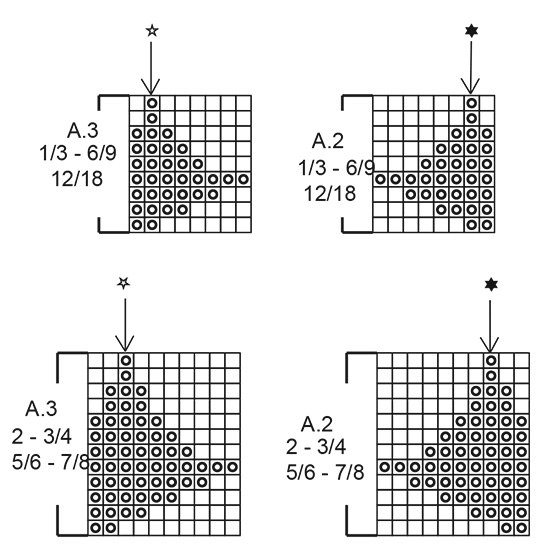
|
|||||||||||||

|
|||||||||||||
|
Have you made this or any other of our designs? Tag your pictures in social media with #dropsdesign so we can see them! Do you need help with this pattern?You'll find tutorial videos, a Comments/Questions area and more by visiting the pattern on garnstudio.com. © 1982-2024 DROPS Design A/S. We reserve all rights. This document, including all its sub-sections, has copyrights. Read more about what you can do with our patterns at the bottom of each pattern on our site. |
|||||||||||||







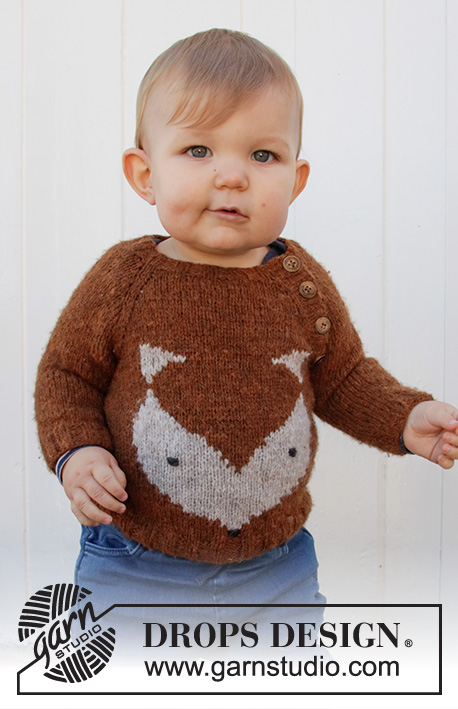


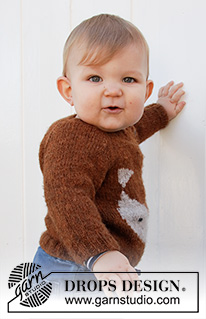

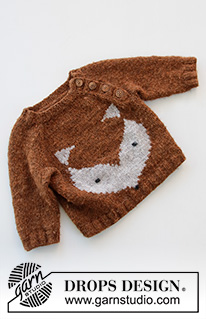



















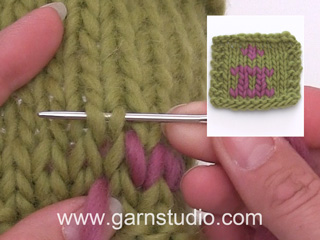







































Comments / Questions (78)
Bonjour j'aimerais savoir si on peut avoir une explication pour 2aiguilles et non aiguille circulaire. ? Merci
12.12.2021 - 19:04DROPS Design answered:
Bonjour Anne-Marie, nous ne pouvons malheureusement pas ajuster chacun de nos modèles à chaque demande, toutefois, cette leçon pourra vous aider. Bon tricot!
13.12.2021 - 10:01Bonjour j\'aimerais savoir si on peut avoir l\'explication pour tricoter avec 2 aiguilles et non en aiguilles circulaires?? Merci
12.12.2021 - 19:03Salve, io non ho capito come si fa a far venire il disegbo ben piatto lavorando in tondo. Sto usando 5 fili x la prima parte della volpe come avete scritto nei suggerimenti. Ma il disegno mi viene in rilievo. C'è un video specifico x la lavorazione in tondo? Perchè quello dei colori si riferisce alla lavorazione su ferri dritti
08.12.2021 - 10:56DROPS Design answered:
Buonasera Martina, ci può spiegare meglio cosa intende per lavorazione in rilievo? Con la lavorazione a più colori in tondo deve portarsi dietro il filo non in uso sul retro del lavoro avvolgendolo regolarmente al filo di lavoro sul retro. Buon lavoro!
08.12.2021 - 18:13Hallo miteinader, gibt es zu diesem zuckersüßen Pullover eigentlich auch eine deutsche Anleitung? Bis jetzt habe ich keine gefunden. Gruß Regine Conzelmann
02.11.2021 - 10:25DROPS Design answered:
Liebe Frau Conzelmann, ja sicher, alle unsere Anleitungen sind auch auf deutsch erhältlich - klicken Sie bei der Dropdown Menu unter dem Foto um die Sprache zu ändern und die deutsche Anleitung zu finden. Viel Spaß beim stricken!
03.11.2021 - 07:59I’m working on the sleeve it says after decrease: when sleeve measures 16cm -61/4” after division ( does after division mean after last decrease or where you pick up the stitches under arm? ) thank you
21.10.2021 - 17:24DROPS Design answered:
Dear Cheryl, yes, "divison" is where you divided the stitches for body and the sleeves. Happy Stitching!
21.10.2021 - 23:29Buongiorno! Sto facendo il maglioncino nella taglia 12/18 mesi. Alla fine del raglan (15 aumenti), partendo dalle 68 maglie alla fine delle coste, come faccio ad avere 188 maglie? Devo aumentare 120 maglie???? Ho capito male o c'è un errore? Grazie per la risposta
13.10.2021 - 12:53DROPS Design answered:
Buonasera Piera, non ci sono errori: quando lavora gli aumenti deve seguire il SUGGERIMENTO PER GLI AUMENTI all'inizio delle spiegazioni e si aumentano 8 maglie per ogni giro di aumenti, quindi 8x15 = 120 maglie aumentate. Buon lavoro!
13.10.2021 - 18:26Sorry hab nochmal nachgelesen, es steht einschließlich 2 Randmaschen. Danke
07.10.2021 - 09:03Ich habe doch 60 M + 2 Randmaschen angeschlagen, also bleiben dann 2 Maschen übrig?
07.10.2021 - 08:59Liebe Wanda, ich habe begonnen die zweite Größe zu stricken. 60 M Anschlag + 2 RdM=62 M Dann: 1RdM, 1 M r/1. Markierer, 7 M/2. Markierer, 23 M/3. Mark., 8 M/4. Mark., 18 M/5. Mark., 1 M r, 1 RdM=60 M, bleiben 2 M übrig?
06.10.2021 - 08:21DROPS Design answered:
Liebe Frau Steiner, so sehen die 60 M aus: 1 RandM, 1 M, (1. Mark), 7 M (+4 = 11 M), (2. Mark), 23 M (+2= 25 M), (3. Mark), 8 M (+4 = 12 M), (4. Mark), 18 M (+ 2M), (5. Mark),1 M, 1 RandM = 1+1+7+23+8+18+1+1=60 und nach Zunahmen = 1+1+11+25+12+20+1+1=72 M. Viel Spaß beim stricken!
06.10.2021 - 16:11Bonjour, je ne comprends pas pourquoi si on tricote de haut en bas, on commence par le diagramme A1 avant de faire les oreilles? Merci pour votre aide
03.10.2021 - 16:00DROPS Design answered:
Bonjour Françoise, les oreilles ne sont pas tricotées en jacquard, mais rebrodées ensuite au point de mailles (cf ASSEMBLAGE). Bon tricot!
04.10.2021 - 08:29